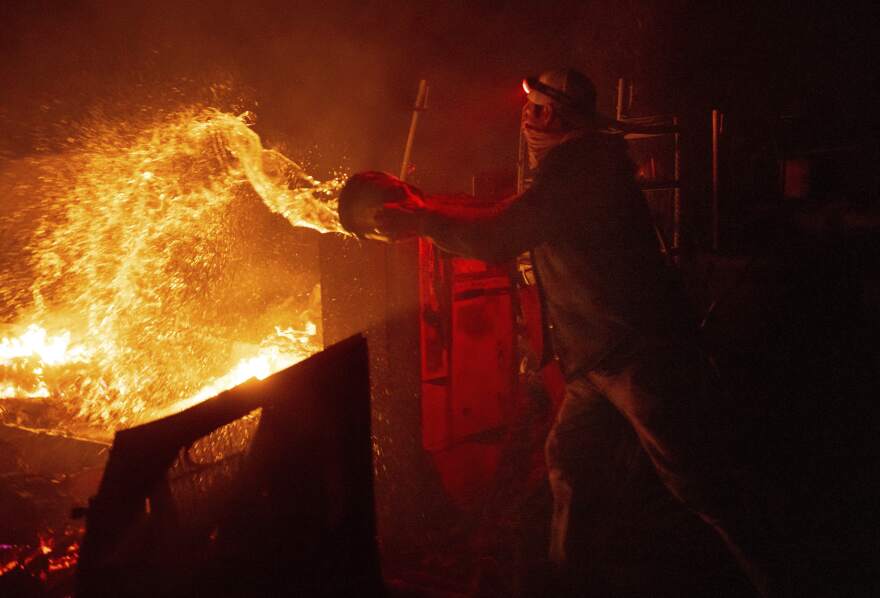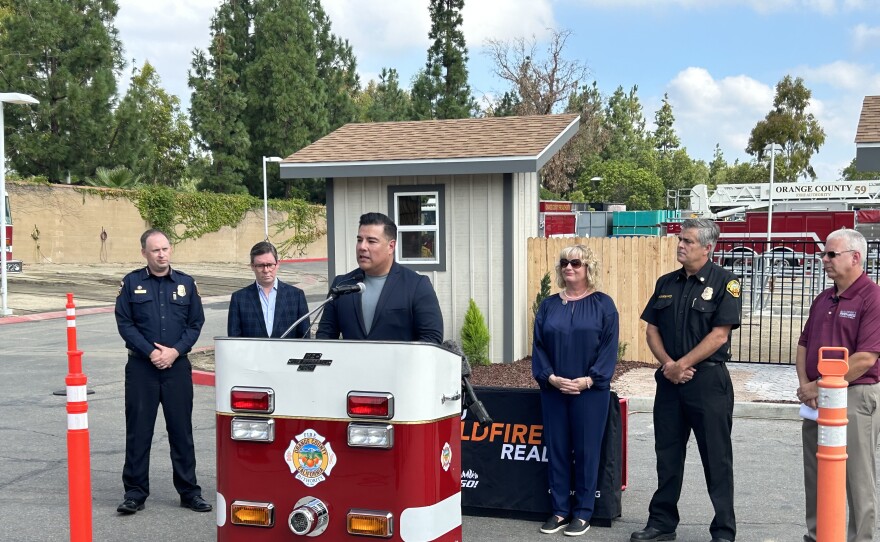Paul Felber’s yard keeps him busy.
“What I really wanted to focus on was trying to restore, as much as possible, a native plant community,” said the 72-year-old, who’s lived in his Alpine home for the last decade. “It’s really hard — it takes a lot of research.”
Yank out the non-native mustard and cat’s ear plants. Nurture the budding Penstemons and California lilacs. Come next year, do it all over again.
But Felber faces an added complication in his botanical quest. His 2-acre property is in an area at high risk of wildfires. That leaves the bespectacled, ponytailed retiree walking a tightrope — trying to foster Mother Nature’s indigenous beauty without building a tinder bed around his home.
“You're always trying to find a balance,” Felber said.

He routinely cuts back the vegetation abutting his house, but he concedes it isn’t perfect. To compensate, he and his wife, Marilyn, have spent upwards of $60,000 hardening their home. They rebuilt their wood deck with fire-resistant materials, installed special ember-blocking vents and replaced their roof.
The investments haven’t impressed home insurance companies. The couple had coverage through The Hartford for seven years, costing about $1,500 annually, before the company dropped them. They switched to a smaller insurance company, which also dropped them after a few years.
Now, the Felbers are stuck with the FAIR Plan, California’s so-called “insurer of last resort.” And their annual bill is about $5,500.
He accepts that his premium will be higher than most homeowners, since he lives in a fire-prone area. But he said the lack of competition in the insurance market is “incomprehensible.”
A rapidly growing number of people in San Diego County have found themselves forced onto the FAIR Plan in recent years, as insurance companies pull back in California. Between 2018 and 2022, the number of FAIR Plan policies countywide more than tripled from 5,385 to 16,679, according to the most recently available data from the Department of Insurance.
This mirrors an alarming statewide trend. The number of Fair Plan policies in California have jumped from roughly 127,000 in 2018 to an expected 400,000-plus by this September. Meanwhile, the plan’s total risk exposure has gone from $50 billion in 2018 to more than $311 billion today.
A Growing FAIR Plan
The high-cost plan is supposed to be a temporary safety net if a homeowner loses their insurance and needs to switch to a new provider. But for many Californians, the FAIR Plan has become the only option — and they’re stuck with it for years.
“The growing FAIR Plan is really what keeps me up at night,” said Ricardo Lara, California’s Insurance Commissioner. “It puts the highest risk properties into one pool.”
Late last year, Lara proposed substantial reforms to how California regulates home insurance. The plan aims to move more homeowners from the FAIR Plan to the traditional insurance market, require more companies to expand policy writing in areas threatened by wildfire and allow insurers to utilize forward-looking catastrophe modeling when requesting rate increases from the state.
Insurance companies and consumer advocates agree on one thing: The state needs to do more to get people off the FAIR Plan. But there’s little consensus between the two sides over how to reach that goal.
Safety net insurance
California mandated the creation of the FAIR Plan in the late 1960s to create a backstop for homeowners who found themselves without insurance. From the start, the plan aimed to move people back into the broader insurance market as quickly as possible.
The FAIR Plan is often erroneously referred to as a government-run insurance plan. While the state mandated its creation, the plan is actually a nonprofit run by an association of insurance companies who do business in California.
FAIR Plan policies only cover fire damage. Homeowners have to secure an additional policy to cover risks such as wind, flooding and theft.
The effects of climate change, including California’s increasingly destructive wildfires, are a driving force behind the dramatic rise in FAIR Plan policies. Seven of the 10 most destructive fires in California’s history have occurred in the last decade, according to Cal Fire.

Insurers also cite high reinsurance and rebuilding costs. As a result, they are drastically cutting back in the state.
Last year, Allstate and State Farm halted new policy writing in California (the latter also announced plans to drop more than 70,000 existing customers.) Farmers, meanwhile, set policy writing limits statewide. USAA announced restrictions based on new stringent wildfire assessment guidelines. Just last week, two more insurance companies announced they will get out of California altogether, leaving nearly 13,000 homeowners searching for new policies.
Victoria Roach, president of the FAIR Plan, declined multiple interview requests from KPBS. However, she spoke to the burgeoning crisis at a legislative hearing last month.
“It’s been a tremendous increase in a very short period of time,” she said. “The FAIR Plan is quickly moving to be the first resort for a lot of people.”
Collateral damage
Everyone with a stake in the home insurance industry — including insurers, consumers, state regulators and the FAIR Plan itself — agrees that a bloated FAIR Plan is bad news.
Industry observers point to Florida as a cautionary tale. The state’s insurer of last resort, Citizens Property Insurance Corp., is now the largest property insurer in the state, with nearly 1.2 million policies. With more than $500 billion in risk exposure, it’s facing scrutiny from Congress over concerns about its solvency. (CEO Timothy M. Cerio argues Citizens Property Insurance has the resources to pay out claims and its solvency is not an issue.)
Former California Insurance Commissioner Dave Jones noted that California’s FAIR Plan is in a better position than its counterpart in Florida.
“But you can see where things might go,” he cautioned, if the state fails to implement robust regulatory reforms, address climate change and mitigate wildfire risks.

FAIR Plan policies are already popping up in suburban and urbanized areas with moderate or low threat of wildfires, as homeowners find themselves left with no other options.
The insurance industry squeeze is even torpedoing real estate transactions.
Greg Fox Jr., a broker associate for Keller Williams Realty in Alpine, estimates up to 25% of his office’s escrows in high wildfire risk areas have fallen through due to insurance issues.
“Nobody really knows at the start of the transaction whether or not they're going to be able to close,” Fox said.
In order to obtain a mortgage, a homebuyer needs secure insurance for the property. A typical real estate contract has an escrow of 30 to 45 days. Some home buyers are unable to secure insurance in time due to the lack of available options and protracted response times from an overburdened FAIR Plan, Fox said.
And when a buyer does find a policy, he added, it often costs much more than they expected. That can alter a buyer’s debt-to-income ratio, leaving them unqualified for the loan, or turn them off from buying the home altogether.
It’s a new riddle in what’s already an expensive — and vexing — real estate market in California.
“Five-plus years ago, nobody had problems getting insurance,” Fox said.
Regulatory reform efforts
In September, Gov. Gavin Newsom issued an executive order urging Lara to “take swift action to address issues with the insurance market and expand coverage options for consumers.” The order came after a bill died in the state Legislature that aimed to expand insurance coverage for homes in areas threatened by wildfires.
Shortly after Newsom’s order, Lara announced the Sustainable Insurance Strategy, which he dubbed “the largest insurance reform in more than 30 years” in California.
The proposal would require insurance companies to write 85% of their statewide market share in “wildfire-distressed areas,” where the FAIR Plan has become the primary insurer for many residents. Lara argues the mandate will increase competition and insurance options in areas where companies have pulled back.

In exchange, insurance companies would be able to use so-called “catastrophe modeling” when submitting rate increase requests to the Department of Insurance. The models provide a forward-looking assessment of the risks posed by climate change and wildfires, among other factors. The companies could also include the cost of reinsurance in their rate requests.
Insurers appear to be generally on board with the proposal but are monitoring how the details shakeout.
“Companies do believe that the strategy would enable them to at least stabilize and, for some, grow again in California,” said Rex Frazier, president of the Personal Insurance Federation of California, which represents some of the largest insurers in the state.
But Consumer Watchdog, a frequent critic of the insurance industry, has expressed skepticism about the Sustainable Insurance Strategy. The organization wants to see more concessions from insurers.
“California homeowners are really hurting,” said Carmen Balber, executive director of Consumer Watchdog. “The insurance industry has created this crisis.”
Balber said her organization is open to the use of catastrophe models for setting insurance rates but believes the data and calculations that feed them should be open to review to prevent unfair price increases.
Frazier argues private companies would balk at letting the public tinker under the hood of their models. “If you press too hard on transparency …then we won't have access to those models,” he said.
Balber also questions the requirement that insurers write 85% of their statewide market share in high-risk wildfire zones. She worries there could be loopholes lurking in the details.

Finally, Consumer Watchdog is urging the Legislature and Department of Insurance to pass a rule that would give homeowners a right to purchase private home insurance — and avoid the FAIR Plan — if they met the state’s Safer From Wildfire guidelines for defensible space and home hardening
Frazier grew irritated when asked for his opinion on this proposal.
“I'm partly in disbelief you would even ask the question,” he said in an interview with KPBS. “It shows so little understanding of what is happening right now.”
The waiting game
Lara entered office as Insurance Commission in 2019. KPBS asked him in an interview why it took nearly five years to introduce major regulatory reform to address the bloated FAIR Plan and insurance companies’ retreat in California.
“Nobody anticipated what Mother Nature has really done to California,” Lara said, referring to the devastating wildfires, storms and flooding endured by the state in the last five years. “This has really put a strain recently on our department and on the insurance market.”
Yet, climate scientists have sounded the alarm for decades about the dangers of climate change, and Cal Fire has warned for years about increasingly destructive wildfires.
When pressed, Lara said the department needed time to consult with industry experts and meet with residents before developing his plan.
“Our Sustainable Insurance Strategy is really informed by those countless meetings that we've had in every single county in California — that’s unprecedented,” he said. “I have the torch now and this is happening under my watch, and so we're gonna get it fixed.”
Lara has set a goal of finalizing the Sustainable Insurance Strategy by the end of the year.
Felber, the Alpine resident, is hopeful the plan will result in more predictable premium costs. But he said he’ll believe the change when he sees it.
“It leaves me hanging out in the wind while, from my perspective, corporate America and government try to come to some agreement,” he said.






